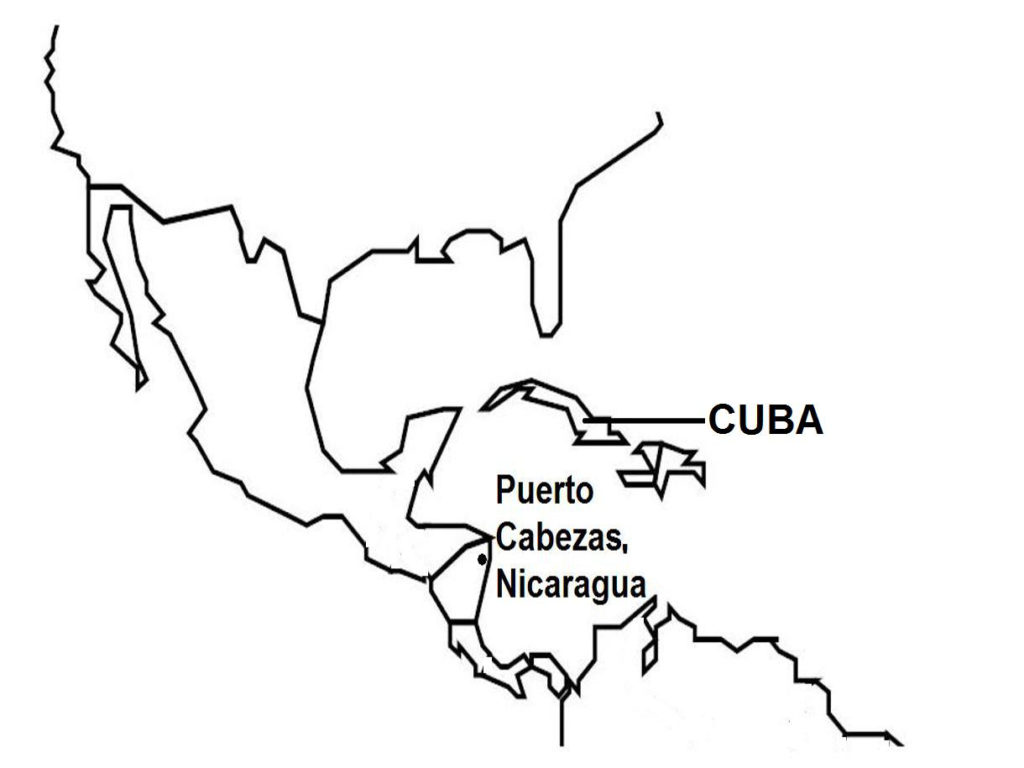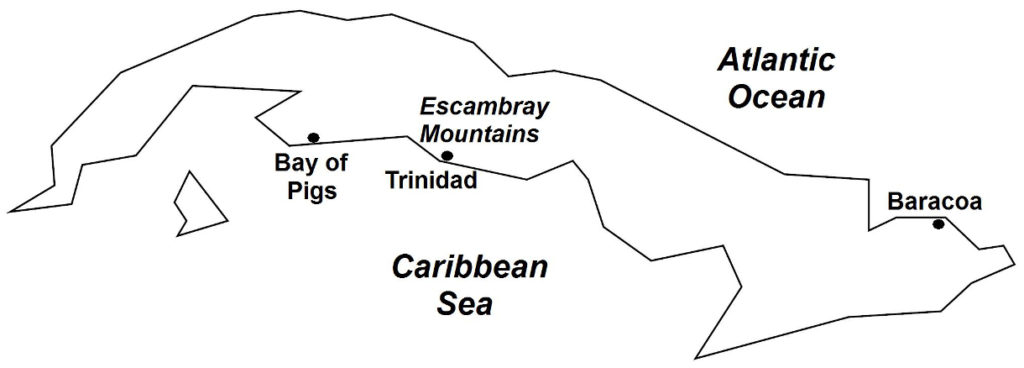By mid-morning on April 17, 1961, Cuban leader Fidel Castro had mobilized his armed forces and regional militias, sending advance units comprising 20,000 soldiers and auxiliary fighters from the north and east toward the Bay of Pigs. In total, some 50,000 Cuban soldiers and militia fighters took part in the war. The sheer weight of the Cuban Army advance forced Brigade 2506 paratroopers to withdraw from Palpite, which then was recaptured by government forces. Other Castro units sealed off the roads leading to Covadonga and Yaguaramas. By the end of the first day, Castro’s forces had contained the landings to the Bay of Pigs and nearby areas, with little chance of a break out; Brigade 2506 was practically trapped on all sides, except from the sea.

(Taken from Bay of Pigs Invasion – Wars of the 20th Century – Volume 2)
Early on April 18, the invasion force at Playa Larga abandoned the beachhead and withdrew to Playa Giron where, together with other Brigade 2506 units, prepared a better defensive position. Playa Larga soon was retaken by Cuban government forces. From the northeast, Cuban Army infantry, supported by tanks, artillery, and air power, also began advancing in the direction of Playa Giron, forcing the Brigade 2506 paratroopers at San Blas to withdraw to the main landing zones at the beaches.
In Washington, D.C., the CIA, meeting with President Kennedy and top government and military officials, appealed for direct U.S. military intervention. President Kennedy rejected the request but offered a compromise: air cover for Brigade 2506. On the morning of April 19, a small squadron of U.S. light bombers took off from Nicaragua for Cuba. However, a communications error relating to the time zone differences between Cuba and Nicaragua prevented American fighter escorts from meeting and protecting the bombers before entering Cuban air space. Proceeding anyway, two of the American bombers were shot down by Cuban planes; ultimately, the air mission failed to relieve the beleaguered invasion forces on the Cuban beaches.
In the afternoon of April 19, the Brigade 2506 force in Playa Giron surrendered in the face of overwhelming ground and air attacks from the Cuban Armed Forces. Small bands of stragglers held off capture by hiding in the swamps, but finally gave up from hunger and exhaustion. Some 1,200 Brigade 2506 soldiers were taken prisoner and 118 were killed in the fighting; a few dozens managed to escape out to sea, and eventually were rescued by U.S. Navy ships.
Aftermath In December 1962, or twenty months after the failed invasion, in an agreement between Cuba and the United States, Castro freed the Brigade 2506 prisoners and allowed them to return to the United States in exchange for the United States delivering $53 million worth of food and medicines to Cuba. Some 60 wounded and ill prisoners had been returned to the United States a few months earlier, while five were executed in Cuba for past crimes. By December 29, 1962, all surviving prisoners had returned to the United States.
The CIA’s underlying premises for the success of the operation were later revealed to be fraught with errors. American and British intelligence information in Cuba showed that Castro enjoyed wide popularity and that no civilian uprising was likely to occur. The CIA was unsure about the invasion’s success, but believed that once the operation appeared headed for failure, President Kennedy would intervene militarily. Before the invasion, however, President Kennedy had said many times that he would not send American forces, which was what happened. Even Trinidad, the CIA’s original invasion site which had been planned for many months, when presented to the U.S. Armed Forces Joint Chiefs of Staff, gave the amphibious landing only a limited chance of success.

Background of the Bay of Pigs Invasion The rise to power of Fidel Castro after his victory in ethe Cuban Revolution (previous article) caused great concern for the United States. Castro formed a government that adopted a socialist state policy and opened diplomatic relations with the Soviet Union and other European communist countries. After the Cuban government seized and nationalized American companies in Cuba, the United States imposed a trade embargo on the Castro regime and subsequently ended all economic and diplomatic relations with the island country.
Then in July 1959, just seven months after the Cuban Revolution, U.S. president Dwight Eisenhower delegated the Central Intelligence Agency (CIA) with the task of overthrowing Castro, who had by then gained absolute power as dictator. The CIA devised a number of methods to try and kill the Cuban leader, including the use of guns-for-hire and assassins carrying poison-laced devices. Other schemes to destabilize Cuba also were carried out, including sending infiltrators to conduct terror and sabotage operations in the island, arming and funding anti-Castro insurgent groups that operated especially in the Escambray Mountains, and by being directly involved in attacking and sinking Cuban and foreign merchant vessels in Cuban waters and by launching air attacks in Cuba. These CIA operations ultimately failed to eliminate Castro or permanently destabilize his regime.
In March 1960, the CIA began to plan secretly for the invasion of Cuba, with the full support of the Eisenhower administration and the U.S. Armed Forces. About 1,400 anti-Castro Cuban exiles in Miami were recruited to form the main invasion force, which came to be known as “Brigade 2506” (Brigade 2506 actually consisted of five infantry brigades and one paratrooper brigade). The majority of Brigade 2506 received training in conventional warfare in a U.S. base in Guatemala, while other members took specialized combat instructions in Puerto Rico and various locations in the United States.

The CIA wanted to maintain utmost secrecy in order to conceal the U.S. government’s involvement in the invasion. Through loose talk, however, the plan came to be widely known among the Miami Cubans, which eventually was picked up by the American media and then by the foreign press. On January 10, 1961, a front-page news item in the New York Times read “U.S. helps train anti-Castro Force At Secret Guatemalan Air-Ground Base”. Castro’s intelligence operatives in Latin America also learned of the plan; in October 1960, the Cuban foreign minister presented evidence of the existence of Brigade 2506 at a session of the United Nations General Assembly.
In January 1961, the CIA gave newly elected U.S. president, John F. Kennedy, together with his Cabinet, details of the Cuban invasion plan. The State Department raised a number of objections, particularly with regards to the proposed landing site of Trinidad, which was a heavily populated town in south-central Cuba (Map 30). Trinidad had the benefits of being a defensible landing site and was located adjacent to the Escambray Mountains, where many anti-Castro guerilla groups operated. State officials were concerned, however, that Trinidad’s conspicuous location and large population would make American involvement difficult to conceal.
As a result, the CIA rejected Trinidad, and proposed a new landing site: the Bay of Pigs (Spanish: Bahia de Cochinos), a remote, sparsely inhabited narrow inlet west of Trinidad. President Kennedy then gave his approval, and final preparations for the invasion were made. (The “Cochinos” in Bahia de Cochinos, although translated into English as “pigs” does not refer to swine but to a species of fish, the orange-lined triggerfish, found in the coral waters around the area).
The general premise of the invasion was that most Cubans were discontented with Castro and wanted to see his government deposed. The CIA believed that once Brigade 2506 began the invasion, Cubans would rise up against Castro, and the Cuban Army would defect to the side of the invaders. Other anti-government guerilla groups then would join Brigade 2506 and incite a civil war that ultimately would overthrow Castro. Thereafter, a provisional government, led by Cuban exiles in the United States, would arrive in Cuba and lead the transition to democracy.
